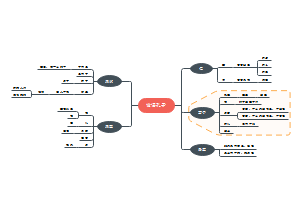导图社区 1生长素 Auxin
- 63
- 0
- 0
- 举报
1生长素 Auxin
生长素(auxin)是一类含有一个不饱和芳香族环和一个乙酸侧链的内源激素,英文简称为IAA,其化学本质是吲哚乙酸。另外,4-氯-IAA、5-羟-IAA、萘乙酸(NAA)、吲哚丁酸等为类生长素。生长素是第一个被发现的植物激素。生长素中最重要的化学物质为3-吲哚乙酸。
编辑于2022-12-19 22:42:42- 植物生理学
- 植物激素
- 生长素
- 相似推荐
- 大纲
生长素 Auxin
Discovery of Auxin
1890s
Darwin studied phototropism –movement towards light
1913
Boysen-Jensen showed that the transmitted influence can move through a gelatin block
1930s
Auxin was purified and shown to promote growth、
Auxin’s root-promoting properties were also known.
Different tissues were recognized to have different sensitivities to auxin
Polar transport of auxin was recognized.
Types and Structure of Auxin
Naturally occuring
IAA
4-CI-IAA
IBA
Synthetic Auxins
NAA
Dicamba
Biosynthesis
IPA pathway-吲哚-3-丙酮酸途径
The IPA pathway is a conserved two-step pathway. The activity level of the two enzymes are regulated in diverse ways
Metabolism of Auxin
Auxin homeostasis is also regulated by conjugation and degradation
GH3(IAA氨基化合成酶)
Overexpression of an auxin conjugating enzyme encoded by a GH3 gene reduces auxin levels in the plant and causes a dwarfed phenotype.
DAO(双加氧酶)
Polar Auxin Transport
Feature
Auxin moves long distances through the phloem.
Auxin also moves via auxin transport proteins.
Auxin normally moves from the tip of the shoot towards the tip of the root. At the root tip, auxin changes direction and moves short distances up the root again (basipetally).
Coleoptiles or shoots move auxin to the shaded side
Gravitropism is a response to a change in orientation relative to gravity
Bending is caused by differential growth mediated by different auxin accumulation
Auxin accumulates on the lower side of roots, but they bend down
chemiosmotic model (化学渗透模型)
1. IAA enters cell either passively (IAAH) or actively (IAA-)
2. Cell wall is maintained at acidic pH by H+-ATPase
3. IAA predominates in cytosol
4. IAAanions exit cell via auxin anion efflux carriers (PIN proteins)concentrated at the basal end of cell.
Auxin has two methods of entering the cell
Passive diffusion
Cooperative transport driven by the proton dynamic potential – the inwardcotransporter AUX
The AUX1/LAX influx carriers contribute to movement of IAA into the cytoplasm.
Transporter
AUX1 takes up auxin into the cell
Auxin transport is facilitated by AUX1/LAX proteins
The ABCB proteins are important for auxin transport
PIN
PIN auxin efflux carriers are encoded differentially expressed genes
PIN is a plasma membrane protein with transmembrane segments and a large hydrophilic loop between transmembrane segments five and six
PIN proteins orient asymmetrically in plant cells
Different PIN proteins orient differently
PIN2 localizes to the lower surface of root cortex cells and the upper surface of epidermal cells
PIN3 changes polarity in response to a change in the gravity vector
The distribution of PIN proteins contributes to the auxin gradients
PIN protein distributions contribute to auxinmediated patterns
Perception and signaling
SCF
The auxin-receptor TIR1 is a component of the SCF ubiquitin ligase complex SCFTIR1
Auxin acts like a molecular glue that holds coreceptor proteins together
The canonical auxin signaling pathway
Aux/IAA proteins repress the activity of Auxin Response Factors (ARFs)
Model for auxin-regulated transcriptional control
Low auxin level
Some ARFs are complexed with Aux/IAA repressors, interfering with their action
Physiological Function
Auxin-induced cell elongation also contributes to growth control
During embryonic development, IAA is dependent from the establishment of zygotic polarity, the formation of the raderogen and root apical meristems, to the formation of stem apical meristems
In the model for auxininduced cell wall elongation, auxin stimulates a plasmamembrane bound proton pump, which acidifies the cell wall
Wall acidification activates wall loosening enzymes called expansins
During Arabidopsis embryogenesis, an auxin gradient forms that is necessary for root formation
Auxin acts like a morphogen at the root apex
Cells experiencing a low auxin level elongate and differentiate
Cells near the tip experience intermediate auxin levels and divide frequently
Ullagen differentiation and formation of root apical meristem are closely related to auxin signaling
During the first division of the embryo forming a two-cell stage, PIN 7 is localized to the top plasma membrane of the basal cell, inducing the transport of auxin from the adjacent basal cell to the top cell, in which auxin accumulates. At the spherical embryo stage, PIN 1 appears at the basal plasma membrane of the cell, meanwhile, PIN 7 turns to the basal plasma membrane of basal cells and PIN 4 begins to be expressed at the base of the embryo, thus inducing auxin transport from the embryonic cell to the radicagen and promoting radicagen development.
IAA is the major hormone that regulates apical cell division and differentiation
PIN 1 is a major mediator of IAA transport to quiescent centers and root crowns
PIN 2 is the major mediator of the reflux transport of IAA along the apical lateral root crown and epidermis to the basalmeristem zone
PIN 3 protein localized in root crown columnar cells mediate transport of auxin to the lateral root crown
PIN 4 is expressed in the quiescent center and surrounding cells and regulates the content of IAA in the quiescent center, makingthe quiescent center the highest point of IAA concentration









